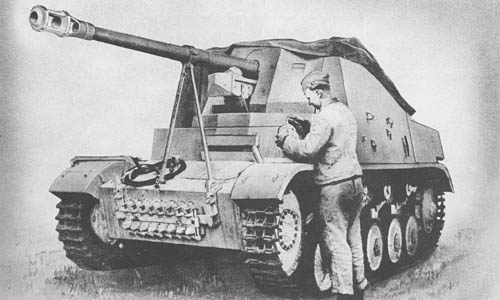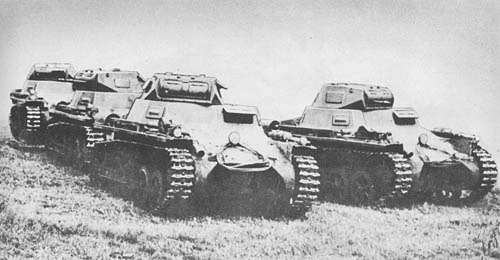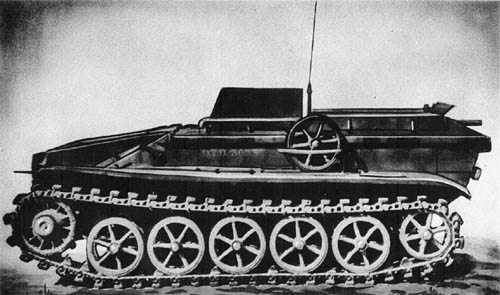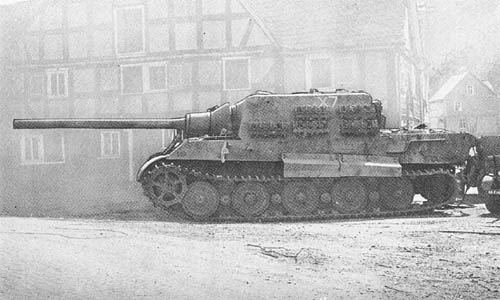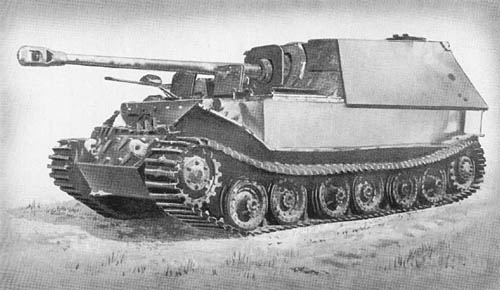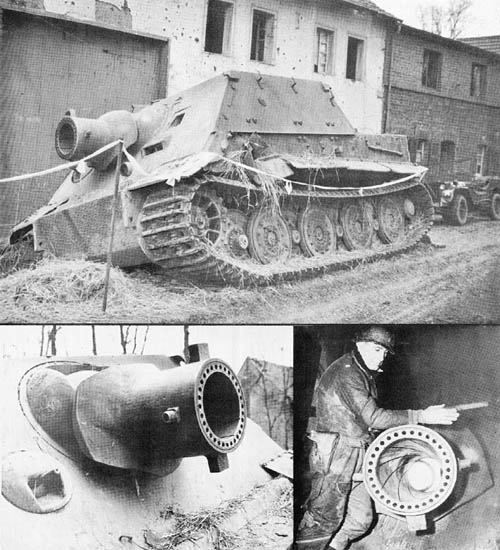
This equipment consists of a 38 cm rocket projector (Raketen Werfer 61) mounted on a modified Model E Tiger I chassis (see p. 38). A heavy rectangular superstructure of the type used on the German self-propelled guns replaces the normal superstructure and turret of the Model E. The rocket projector is mounted in the front plate of the superstructure, offset to the right of center. The superstructure is made of rolled armor plates and is of welded construction with the side plates interlocked with the front and rear plates. A heavy strip of armor is used to reinforce the joint between the front plate and glacis plate on the outside. Armor thickness varies from 40 mm to 150 mm.
The main armament, which fires a splined projectile 58.6 inches long (see page 354.2), differs radically in design and construction from any weapon previously examined. The barrel consists of a cast outer jacket, and a spaced liner of 1/2-inch steel. The latter, which is 74 1/4 inches long, is rifled, having nine grooves with right hand twist, one turn in 17.6 calibers. At the extreme rear, the grooves widen to aid in positioning splines near the base of the projectile. The liner is held in place by four steel blocks at the rear, and a perforated ring at the muzzle end. This ring has 31 equally spaced holes around its face. The breech mechanism is a horizontal sliding plate 2-5/16 inches thick opening from left to right.
The propellant gases are deflected between the tube and liner by an unusual obturator, and escape through a perforated ring at the muzzle. The metal obturator comprising a thin “L” shaped outer ring, a heavier “L” shaped perforated inner ring, and a spacer ring, fits into a circular recess in the front face of the breech plate. When the projectile is fired, the propellant gases pass through the ports to the chamber between the inner and outer rings. The face of the outer ring is forced against the rear face of the tube, and the sides against the recess in the breech plate, thereby obtaining the gas seal.
SPECIFICATIONS
| (VEHICLE) |
| Weight (in action) (estimated) |
|
68 tons |
| Length (overall) |
|
20 ft., 8 1/2 ins. |
| Width (overall) |
|
12 ft., 3 ins. |
| Height (overall including stowage crane) |
|
11 ft., 4 ins. |
| Height (overall less stowage crane) |
|
9 ft., 3 ins. |
| Ground clearance |
|
17 ins. |
| Tread centers |
|
9 ft., 3 1/2 ins. |
| Ground contact |
|
12 ft., 6 ins. |
| Width of track |
|
28 1/2 ins.—20 1/2 ins. |
| Pitch of track |
|
5 1/8 ins. |
| Track links |
|
96 |
| Fording depth |
|
70 ins. |
| Theoretical radius of action |
| Roads |
|
87 miles |
| Cross-country |
|
53 miles |
| Speed |
| Roads |
|
25 miles |
| Cross-country |
|
15 miles |
| Superstructure Armor |
| Front plate |
|
150 mm at 45° to vertical |
| Projector mantlet (average) |
|
69 mm rounded |
| Projector shield (average) |
|
150 mm rounded |
| Side plates |
|
84 mm at 20° to vertical |
| Rear plate |
|
84 mm at 10° to vertical |
| Top plate |
|
40 mm |
| Spherical cradle |
|
100 mm rounded |
| Ammunition (Rds.) |
|
12 |
| Engine |
|
Maybach HL 210, V-12, 630 hp. |
| Transmission |
|
Preselector, hydraulic—8 speeds forward, 4 reverse |
| Steering |
|
Controlled differential, hydraulic |
| Crew (unconfirmed) |
|
7 |
| |
| (PROJECTOR) |
| Caliber |
|
380 mm (14.96 ins.) |
| Length of tube |
|
81 1/8 ins. |
| Length of liner |
|
74 1/4 ins. |
| Thickness of liner |
|
1/2″ |
| No. of grooves |
|
9 |
| Width of grooves |
|
0.4 in. |
| Width of grooves at rear |
|
1.06 in. |
| Depth of grooves |
|
0.2 in. |
| Twist of grooves |
|
Right hand, one turn in 17.6 caliber |
| Max. range (horizontal) |
|
6,179 yds. |
| Firing mechanism |
|
Continuous-pull |
| Traverse |
|
20° |
| Elevation (approx.) |
|
85° |
| Depression (approx.) |
|
0° |
| Ammunition |
|
H.E. (R. Sprenggranate 4581) |
| |
|
HEAT (R. Hollandungsgranat 4592) |
| Wt. of projectile* |
|
761 lbs. |
| *Weight zones are marked to the nearest 5 kg. (12 lbs.)
German: p. 38.3-38.4 (June 1, 1945)
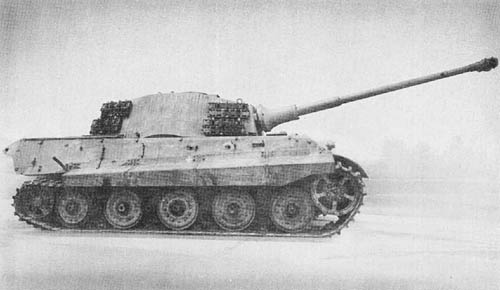
This heavy tank designed for defensive warfare or for penetrating strong lines of defense made its combat appearance in 1944. It is distinguished by heavy frontal armor and by the employment of the heaviest German gun to be used in a turret with 360° traverse—the 8.8 cm Kw. K. 43 (L/71). This gun has a muzzle velocity of 3,280 f/s, and firing an A.P.C.B.C. projectile weighing 22.4 pounds against 30° homogenous plate has a reported penetration of 6.3 inches at 1,000 yards.
The hull and superstructure are of single-skin welded construction with interlocked joints. The hull front is formed of a single sloping plate 150 mm thick, and a lower nose plate 100 mm thick. Each of these plates is set at an angle of 50° from the vertical, resembling in design the Panther rather than the earlier Tiger. The pannier side plates, 80 mm thick, are set at a 25° angle and also resemble those of the Panther. The turret is located sufficiently back of the angle of deflection to be clear of direct hits on the front plate. The rounded front is 180 mm thick.
At the rear of the vehicle is a Maybach 60°, V-12, gasoline engine of 600 horsepower. The transmission, steering, and final drive are similar to those of the Tiger E. The suspension is made up of nine torsion bars on each side to carry the tank on steel tired road wheels. Five of these overlap the four internal ones. Every alternate track link has two ground contact bars.
This tank mounts the 8.8 cm Kw. K. 43 (L/71), two M.G. 34’s, an antiaircraft machine gun, and a smoke projector. A commander’s version of this tank was also manufactured.
The transport trailer for this tank is described on page 62.2.
SPECIFICATIONS
| Weight |
|
75 tons |
| Length |
|
23 ft., 10 ins. |
| Width (overall) |
|
12 ft., 7 ins. |
| Height |
|
10 ft., 2 ins. |
| Ground clearance |
|
1 ft., 5 ins. |
| Tread centers |
|
9 ft., 4 ins. |
| Ground contact |
|
|
| Width of track |
|
32.5 ins. |
| Pitch of track |
|
5.9 ins. |
| Track links |
|
90 |
| Fording depth |
|
69 ins. |
| Theoretical radius of action |
| Roads |
|
106 |
| Cross-country |
| Speed |
| Roads |
|
23.6 m.p.h. |
| Cross-country |
|
10 m.p.h. |
| Armor |
| Front glacis plate |
|
150 mm |
| Sides |
|
80 mm |
| Armament |
|
(1) 8.8 cm Kw. K. 43; (2) 7.92 mm M.G.’s; (1) A.A. M.G.; (1) smoke projector |
| Ammunition (Rds.)—88 mm |
|
80 |
| Engine |
|
Maybach HL 230 |
| Transmission |
|
8 forward speeds; 4 reverse |
| Steering |
|
Controlled differential, hydraulically operated |
| Crew |
|
5 |
German: p. 38.2 (August 1, 1945)
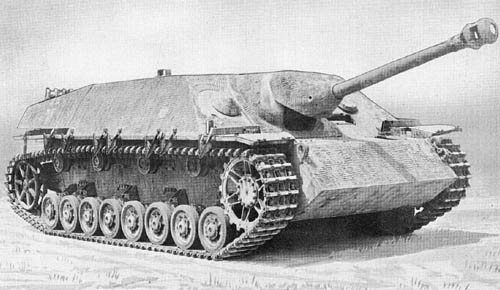
This equipment consists of a Pz. Jäg. IV chassis upon which is mounted a 7.5 cm Pak 39 (L/48). The chassis is a modified Pz. Kpfw. IV, designed to mount either the 7.5 cm Pak 39 (L/48) or the 7.5 cm Stu. K. 42 (L/70).
The chassis has upper and lower nose plates sloped at 45° and 57° respectively. The all-welded construction of the hull is retained, and this structure is strengthened by limited interlocking of the front plates. The main armament is mounted in the sloping front plate of a squat all-welded superstructure, and is offset 8 inches to the off-side of the center line. The mounting is of gimbal type, and is protected externally by a heavy casting. The superstructure is bolted through angle sections to the lower hull. The sloping sides of the superstructure are extended beyond the vertical hull sides over the width of the tracks, and the rear edges of the floor of the sponsons so formed are locked upon the hull angle section. The rear superstructure and engine cover plates are similar to those of the Pz. Kpfw. IV. Spaced plates of 5 mm armor are bolted to brackets welded to the basic side plates of the rear superstructure sides. The armor is treated with Zimmerit. Mechanically, the vehicle is similar to the Pz. Kpfw. IV, but with small modifications. The final spur gear carries 41 teeth instead of the 40 on the tank. The final drive sprockets are of cast steel with webs of flat section instead of the rounded spokes of the tank sprockets.
SPECIFICATIONS
| Weight |
|
|
| Length |
|
19 ft., 4 ins. |
| Width |
|
9 ft., 7 ins. |
| Height |
|
|
| Ground clearance |
|
15 ins. |
| Tread centers |
|
7 ft., 11 ins. |
| Ground contact |
|
11 ft., 6 ins. |
| Width of track |
|
15 ins. |
| Pitch of track |
|
4 3/4 ins. |
| Track links |
|
98 |
| Fording depth |
|
3 ft. |
| Theoretical radius of action: |
|
|
| Roads |
|
130 miles |
| Cross country |
|
80 miles |
| Speed: |
|
|
| Roads |
|
28 m.p.h. |
| Cross country |
|
15 m.p.h. |
| Armor: |
|
|
| Front plate of superstructure |
|
60 mm at 50° angle |
| Sides of superstructure |
|
30 mm at 30° angle |
| Armament |
|
7.5 cm Pak 39 (L/48) |
| Ammunition (Rds.) |
|
|
| Engine |
|
Maybach HL 120 TRM, 320 hp. |
| Transmission |
|
Synchromesh—6 speeds forward, 1 reverse |
| Steering |
|
Epicylic, clutch brake |
| Crew |
|
5 |
German: p. 34.2 (August 1, 1945)
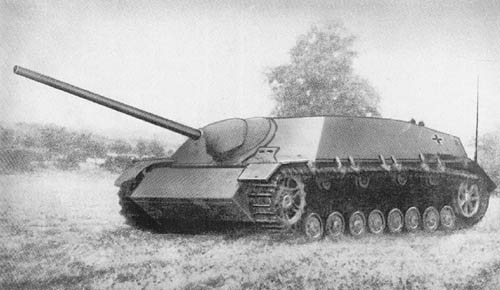
This self-propelled antitank gun consists of the 7.5 cm Stu. K. 42 (L/70) mounted on a modified Pz. Kpfw. IV chassis.
The vehicle is of all-welded construction except that the fighting compartment roof is bolted. The upper and lower nose plates are interlocked with each other and with the hull sides. The upper nose plate, set at an angle of 45° to the vertical, has a thickness of 80 mm. The lower nose plate, set at an angle of 55° to the vertical, has a thickness of 45 mm. The superstructure front plate is interlocked with the superstructure side plates and additional strength is provided by two brackets which are welded into recesses in the hull sides and bolted to plates welded to the superstructure front.
The crew compartment occupies the front three-quarters of the vehicle and accommodates a crew of five. The remaining quarter houses the engine which is the standard Maybach HL 120 as fitted in the Pz. Kpfw. IV.
The gun, which has no muzzle brake, is ballistically similar to the 7.5 cm Kw. K. 42 as mounted on the Pz. Kpfw. Panther. It is located eight inches to the right of the hull center line. The hydraulic buffer and hydropneumatic recuperator are mounted above the piece, the buffer being on the left. The recoil gear is protected by a cast mantlet with curved outer surfaces. Stowage is provided for 55 rounds of ammunition, all except four being stowed horizontally.
A port is provided in the superstructure front plate to the right of the 7.5 cm gun, behind which is a small machine gun ball mounting, five inches in diameter.
SPECIFICATIONS
| Weight (approx.) |
|
28 tons |
| Length |
|
19 ft., 9 1/2 ins. |
| Width |
|
10 ft., 4 /4 ins. |
| Height |
|
6 ft., 5 ins. |
| Ground clearance |
|
15 ins. |
| Tread centers |
|
8 ft., 1 1/4 ins. |
| Ground contact |
|
11 ft., 6 ins. |
| Width of track |
|
15 ins. |
| Pitch of track |
|
4 3/4 ins. |
| Track links |
|
98 |
| Fording depth |
|
3 ft. |
| Theoretical radius of action |
|
|
| Roads |
|
130 miles |
| Cross-country |
|
80 miles |
| Speed |
|
|
| Roads |
|
28 m.p.h. |
| Cross-country |
|
15 m.p.h. |
| Armor |
|
|
| Superstructure, front |
|
80 mm at 50° to vertical |
| Superstructure, sides (fighting compartment) |
|
40 mm at 30° |
| Gun Mantlet |
|
150 mm (rounded) |
| Upper nose plate |
|
80 mm at 45° |
| Lower Nose plate |
|
45 mm at 55° |
| Hull sides |
|
30 mm (vertical) |
| Armament |
|
7.5 cm Stu. K. 42 (L/70); one M.G. |
| Ammunition (Rds.) |
|
55 |
| Engine |
|
Maybach HL 120 TRM, 320 hp. |
| Transmission |
|
Synchromesh—6 speeds forward, 1 reverse |
| Steering |
|
Epicyclic, clutch brake |
| Crew |
|
5 |
German: p. 32.3 (May 1, 1945)
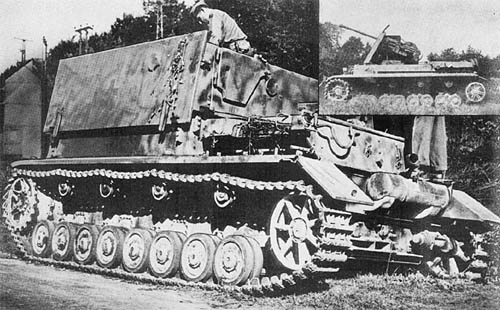
This equipment consists of the standard Pz. Kpfw. IV chassis adapted to mount the 3.7 cm Flak 43. It is essentially an antiaircraft weapon, although the gun may be depressed for use against ground targets.
The superstructure is especially designed for the second purpose. The side and rear walls of the structure are two spaced 15 mm armor plates nine feet long, eight feet, eight inches wide, and four feet high. The sides can be pushed outwards and downwards to a horizontal position to permit fire against ground targets or to extend the area of the loading platform.
The 3.7 cm Flak 43, which has a 360° traverse and 90° elevation, is centrally mounted on a pedestal. It is hung from a single trunnion on the right through which passes the feed and ejection aperture. The monobloc barrel is fitted with a combination muzzle brake and flash hider. Both elevating and traversing handwheels are located to the right of the gun. A hydromatic-spring buffer with variable recoil is situated below the barrel, and two return springs lie side by side above the barrel. A tri-sectional gun shield sloped at 30° to the vertical is provided. The center section is 9 mm thick and two side sections each 6 mm thick. The height of the shield, measured up the slope, is four feet, 3 1/2 inches. The gun is fed horizontally from the left by clips of eight rounds each which are placed on a fixed loading tray.
The muzzle velocity of the 3.7 cm Flak 43 is reported as 2,750 f/s, and its theoretical rate of fire 250 rounds per minute. The ammunition issue laid down per equipment is reported as 1,600 rounds, 1,280 high explosive and 320 armor piercing.
An official German document states that the standard sight for this gun will be the Schwebedornvisier.
SPECIFICATIONS
| Weight |
|
26 tons (est.) |
| Length |
|
19 ft., 4 ins. |
| Width |
|
9 ft., 7 ins. |
| Height |
| Ground clearance |
|
15 ins. |
| Tread centers |
|
7 ft., 11 ins. |
| Ground contact |
|
11 ft., 6 ins. |
| Width of track |
|
15 ins. |
| Pitch of track |
|
4 3/4 ins. |
| Track links |
|
98 |
| Fording depth |
|
3 ft. |
| Theoretical radius of action |
| Roads |
|
130 miles |
| Cross-country |
|
80 miles |
| Speed |
| Roads |
|
25 m.p.h. |
| Cross-country |
|
15 m.p.h. |
| Armor |
| Front plate |
|
50 mm |
| Sides |
|
30 mm |
| Armament |
|
3.7 cm Flak 43 |
| Ammunition (Rds.) |
|
1,600 |
| Engine |
|
Maybach HL 120 TRM, 320 hp. |
| Transmission |
|
Synchromesh—6 speeds forward, 1 reverse. |
| Steering |
|
Epicyclic, clutch brake |
| Crew |
|
7 |
German: p. 32.2 (April 1, 1945)
|
